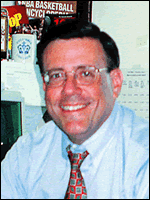 |
 |
 |
 |
|
WITHIN THE FAMILY
Mark Burstein, who's in charge of facilities management at Columbia, was describing the multitude of construction and renovation projects taking place on or around campus recently — projects that, it should be emphasized, have done much to improve the look, utility and spirit of the campus. As he went through his list — from the renovations of Hamilton, Butler and various dorms to the construction at Broadway and 110th Street to plans for the space formerly occupied by the Lion's Court to ongoing discussions about putting a science tower above the gym at Broadway and 120th Street — there was a constant cautionary disclaimer. "Space is our largest constraint as an institution," said Burstein, citing figures that show Columbia has less physical space per student than peer institutions. "Space is the limiting factor in a number of things that we want to do." Sure, it would be great to expand book storage for Butler Library, but where? After seeing how expensive it would be to build out under South Field, it was decided to partner with the New York Public Library and Princeton University for a book storage facility in Princeton, N.J. It's more economical to do that and pay for transporting books to and from campus as needed than to build a storage facility on Morningside Heights. Burstein's lament — I remember him on another occasion aptly describing Columbia as "a space-poor university" — got me to thinking about our January cover story, "The Architecture of Columbia" by Professor Hilary Ballon. Especially about what might have been. Imagine what the University might be like if, a century ago, its leaders had another $1 million or so when they moved the campus to Morningside Heights. That's about all it would have taken to buy up the land west of Broadway, all the way down to the Hudson River. There might have been a Baker Field where Barnard now sits, or a state-of-the-art science center, or a gym truly big enough to accommodate intercollegiate, intramural and recreational athletes alike. The University could have had superior faculty housing to lure the best and brightest from around the country and sufficient student housing for undergraduate and graduate students alike. Columbia didn't have the money back then, so it doesn't have the land now. And when we sing about "Alma Mater on the Hudson Shore," we're not being entirely truthful; "Alma Mater a Couple of Blocks From the Hudson Shore" is more accurate. But remember the words of Whittier: "For of all sad words of tongue or pen, the saddest are these: ‘It might have been.'" Burstein and his boss, Emily Lloyd, are to be commended for their aggressive approach to making the most of every square foot of available space. Their continuing challenge is to find innovative ways to stretch dollars and space so that Columbia's students and faculty have the facilities that they deserve.
|
|
|||||||||||||||||||||||||||||||||||||||||||||||
